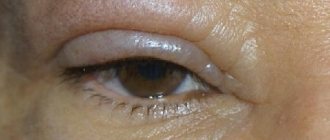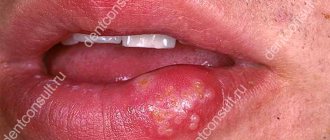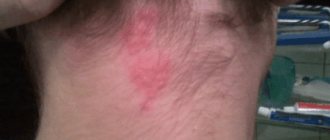What is this disease?
Herpetic stomatitis is a pathological process that develops in the mucous membrane lining the oral cavity. The causative agent of this disease is herpes simplex virus type 1. In children under the age of five, this virus is detected in 60% of all cases. By adolescence, it is detected in the vast majority of people. Herpes stomatitis in children develops during the baby’s first contact with the virus. This occurs most often before the age of three.
The high incidence is explained by:
- low level of production of own antibodies;
- immaturity of cellular immunity;
- the fact that the baby does not receive antibodies from mother's milk;
- high reactivity of the child's body.
If the baby is bottle-fed, he may get sick in the first months of life. Viral infection often goes into a latent state. It persists in the nerve ganglia.
Rash on lips in pregnant women
During pregnancy, certain prerequisites arise for the activation of the herpes virus. The body perceives the fetus as something foreign, and to prevent its rejection, maternal immunity is automatically reduced. The main symptom of the disease is a rash on the lips.
The disease can be primary or recurrent, the effect of the virus on the unborn baby depends on this. If a woman has previously had herpetic manifestations, the probability of danger to the fetus is estimated at approximately 5%. This is explained by the presence of specific antibodies in the blood. If the body has not previously been infected, the risk of fetal pathologies increases markedly.
But a rash on the lips of a pregnant woman is often a sign of hormonal changes in the body, especially in the early stages. The main reason is an increase in progesterone production. Such conditions are not dangerous for either the mother or the child.
Allergies also do not pose any risks to the fetus: the placenta provides reliable protection against allergens and antigens, as well as antibodies that are produced to suppress them. All these substances do not get inside the fertilized egg.
Causes
The cause of the development of the pathology is the herpes simplex virus type 1. It belongs to DNA viruses belonging to the Herpesviridae viral family. The pathogen multiplies rapidly in the epithelial cells of the oral mucosa. Then it enters nearby lymph nodes (submandibular) and continues to reproduce in them. Then it enters the blood and migrates to the parenchymal organs (spleen, liver, kidneys). There it multiplies and enters the bloodstream again. As a result, it again appears in large quantities in the epithelial cells of the skin and mucous membranes. They are massively defeated. It is localized in the oropharynx, oral cavity, nose, lips, and nearby skin. Stomatitis and herpes of the skin and mucous membranes develop when the infection generalizes simultaneously.
Children become infected with it as follows:
- through contact and everyday life (using shared utensils, toys, through kissing);
- airborne (coughing, sneezing);
- from a sick mother to the fetus through the placenta or during childbirth.
A baby can become infected from sick adults, children, and carriers.
The following factors contribute to the development of the disease:
- previously suffered inflammatory processes;
- previous antibiotic therapy;
- deficiency of microelements and vitamins in the body;
- mechanical damage to the skin and mucous membranes;
- insufficient fluid intake;
- poor oral hygiene.
In children, the virus is especially easily transmitted through contact. The infectious process quickly spreads to healthy areas.
Which doctor treats a rash on the lips
A rash near the lips can be a dangerous symptom. If such manifestations occur, you should definitely visit a doctor, undergo prescribed tests and, if necessary, a course of treatment. First, you should visit a dermatologist, who will prescribe diagnostic procedures to identify the disease.
Even if the test for herpes is positive, many more parameters are taken into account when prescribing therapy: the number of antibodies, the stage of the disease, the individual characteristics of the body. This disease has 8 varieties, and appropriate treatment is selected for each.
If a reaction to certain substances and products develops, consultation with an allergist is required. There is often a need to visit an immunologist, since most diseases associated with a rash on the lips progress against a background of weakened immunity. But you should not visit the dentist if you have such symptoms. During dental treatment, the vesicles can become damaged and become infected, which causes inflammation and complications.
Classification
According to the flow, acute, chronic, and wave-like variants of the pathology are distinguished. The following degrees of severity of the pathological process are distinguished:
- Mild - it is typically characterized by a slight increase in body temperature, moderate inflammation of the mucous membrane in the mouth, and enlargement of regional lymph nodes. Rashes form on the mucous membrane and skin.
- Medium – high temperature rises. Severe weakness and sudden deterioration in health. The baby begins to vomit and the pain in the mouth increases. Significant rashes appear in the mouth and the skin around it.
- Severe - a severe headache is added to the pathological process. High temperature rises, severe muscle pain. Not only regional but also distant lymph nodes enlarge. The rashes are located not only in the oral cavity, but on the skin next to it. They appear on the mucous membrane of the eye, on the eyelids, and on other parts of the face.
The severity of the pathology depends on the viral load (the amount of virus in the body) and the general reactivity of the body.
Types of rashes on the lips
Rash on the lips can be of various origins, and externally such skin lesions differ in character, color and other characteristics. The rash can be classified as:
- Blisters are small formations with hemorrhagic or serous contents, their size is 4-5 mm;
- Bubbles - formations with a diameter of 5 mm to several centimeters, usually indicate a long course of the disease;
- Pustules are red or pale pink, filled with pus. They can be located not only on the surface, but also deep under the skin;
- Spots – redness of small areas of the skin;
- Nodules and nodules that can leave scars;
- Erosion and ulcers are neoplasms that violate the integrity of the skin and have transparent or cloudy contents.
Allergic reactions lead to the appearance of small bright pimples, swelling, and edema.
Clinical manifestations
Stomatitis in children is characterized by a gradual onset of the disease. Clinical signs of the disease do not appear immediately after infection. The incubation period is typical for this pathology; it lasts from two days to three weeks.
Symptoms of herpetic stomatitis in children appear starting from the prodromal period.
Each period has its own clinic:
- Latent – lasts up to two weeks. The child's sleep is disturbed and he refuses to eat. The baby becomes restless and whiny. He has increased salivation, possible nausea and vomiting. The lymph nodes are enlarged and painful on palpation.
- The height of the disease - at this time rashes appear on the skin and mucous membranes. They are located on the soft, hard palate, gums, cheeks, lips and tongue. They are group or single, up to three millimeters in size. They are thin-walled bubbles filled with a clear liquid. Their formation lasts up to four days. The vesicles quickly open, then erosions and painful aphthae form. They are shallow ulcers covered with a white coating. The mucous membrane in the mouth is swollen and bleeding. The child develops a high temperature of up to 40 degrees. A runny nose, cough, and conjunctivitis occur.
- Fading - aphthae, erosions gradually heal and epithelialize. These formations heal without scarring. Often there is a wavy course of the disease. The periods of appearance of rashes alternate with rises in temperature.
The illness usually lasts up to two weeks. In children under one year of age, generalization of the process is possible. The development of sepsis, damage to all internal organs and meninges is likely.
What diseases cause a rash on the lips?
Pimples, redness and other signs of irritation on the lips appear for various reasons. Most often, their appearance is associated with a weakened immune system, which cannot cope with bacteria and viruses.
Rashes appear due to vitamin deficiency, frequent hypothermia and overheating, improper installation of veneers and braces. The cause may be the spread of fungus.
A rash on the lips may indicate the development of:
- Herpes - the disease is provoked by a virus, usually type 1. With this pathology, the rashes become regular and look like groups of small bubbles filled with liquid. Their appearance is accompanied by itching and pain;
- Allergies to cosmetic products, toothpaste, substances contained in food. A feature of rashes of allergic origin is swelling, and at the same time redness appears on the skin;
- Oral dermatitis - the rash is quite profuse, accompanied by peeling and sometimes a decrease in skin sensitivity. The cause of the pathology is disturbances in the functioning of the nervous system, the use of low-quality cosmetics, skin hypersensitivity, prolonged exposure to a solarium or exposure to the sun;
- Fordyce's disease - the disease manifests itself in connection with the expansion of the sebaceous glands against the background of hormonal imbalance and manifests itself as white granules or nodules.
When the rash is accompanied by cracks, peeling, and yellow crusts are visible on the lips, this may indicate cheilitis. The disease progresses due to genetic predisposition, frequent stress, exposure to ultraviolet radiation, and hypovitaminosis. Neoplasms in the form of ulcers with bleeding may turn out to be malignant.
Diagnostics
A patient suspected of having this disease is examined by a dentist. He asks the child’s parents about how the disease progressed. The diagnosis is established on the basis of the characteristic clinical picture of stomatitis, revealed during examination, anamnesis and characteristic complaints. Upon examination, typical mucosal lesions are revealed.
To confirm the diagnosis, laboratory testing of scrapings of the oral mucosa, the contents of ulcers, the patient’s saliva and blood is used.
The following are used for research:
- cytopolymerase chain reaction;
- immunofluorescence method;
- serological blood tests (RSC, ELISA, immunoglobulin M test);
- HSV test for the detection of immunodot G-specific glycoprotein.
These methods are used only for severe infections, as they are quite expensive.
Why is a rash on the lips dangerous?
The degree of danger of a rash on the lips and the likely consequences are determined by the causes of this manifestation. For example, the herpes virus is integrated into the genetic apparatus of cells, rashes appear not only on the face, but also in any places where there are nerve endings. This leads to disruption of the functioning of internal organs. If left untreated, a secondary bacterial infection develops and the wound begins to fester. With a serious decrease in immune defense, herpes can cause dangerous diseases, such as encephalitis.
Allergic reactions also pose certain health risks. With allergies, the body produces antibodies to specific proteins that the allergen contains. Due to the formation of biologically active substances, the heart rate may increase, smooth muscle spasms may occur, and edema may develop. The most dangerous manifestation of the pathology is anaphylactic shock - swelling of the larynx, which can even lead to death.
It is easier to treat any disease at the initial stage, while the pathology has not yet caused significant harm to the body. That is why, if a rash occurs on the lips, you should not try to disguise it or cure it yourself. The best solution would be to visit a doctor who will diagnose and prescribe adequate treatment.
Treatment
Treatment of herpetic stomatitis in children with mild and moderate forms is carried out on an outpatient basis. In severe cases and the development of complications, the baby is hospitalized. Treatment is carried out under the supervision of a pediatric dentist or periodontist.
Children are prescribed bed rest and a diet with pureed, non-irritating food. He is given separate hygiene items and dishes. Plenty of warm fluids are recommended.
The following drugs are prescribed:
- Non-steroidal anti-inflammatory drugs (Nise, Paracetamol, Nurofen) are used to relieve temperature and inflammatory reactions.
- Antihistamines (Clemastine, Loratadine) are used to relieve swelling of the mucous membranes.
- Antiviral drugs (Famciclovir, Acyclovir, Zovirax) are used at the beginning of treatment or in severe cases.
- Immunomodulators (Lysozyme, Gamma globulin, Thymogen) are used to enhance immunity.
During treatment, vitamin-mineral complexes and fish oil are used in monthly courses.
Local drugs that act directly on the mucous membrane are widely used.
For local treatment of herpetic stomatitis the following are used:
- antiseptics (Hexoral, Miramistin) - they are used to rinse the mouth every four hours for two weeks;
- ointments and gels with anesthetics (Kamistad, Lidochlor gel) are used for pain relief, they are lubricated with mucous membranes three times a day for up to two weeks;
- antiviral agents (Ganciclovir, Acicovir) - destroy the viral cell, gums are treated with these ointments five times a day, two weeks;
- proteolytic enzymes (Trepsin, Chymotrypsin) are used to cleanse the necrotic surfaces of ulcers; they are washed with these solutions twice a day.
- rinsing with decoctions of medicinal herbs (calendula, chamomile, sage) is carried out after each meal for up to two weeks;
- epithelializing ointments (Solcoseryl, Methyluracil) are used to enhance the healing of erosions and ulcers, used in the recovery stage, used up to four times a day for ten days.
Physiotherapy is applied locally. Irradiation of affected mucous membranes with ultraviolet and infrared rays is used.
Ointments that are used for rashes on the lips
A qualified doctor should select medications to treat rashes. Attempting to get rid of unpleasant symptoms on your own will, at best, relieve the symptoms without eliminating the cause of the problem. At worst, the situation will worsen.
A rash on the lips caused by the herpes virus is treated with antiviral drugs - for external use or for oral administration. The following ointments are used:
- Acyclovir (Virolex, Zovirax, Acyclostad, Herperax, Gerpevir, Provirsan) is an antiviral agent that penetrates the DNA chain of the virus and stops its replication. However, over time, the effectiveness of the drug decreases, so its use requires justification;
- Penciclovir (Vectavir, Fenistil Pencivir) - enters infected cells without affecting healthy ones. Prevents viral DNA synthesis;
- Docosanol (Gerpanit, Erabazan, Priora) - prevents the connection of the virus with the cell membrane, is prescribed in the initial stages of the pathology.
For Fordyce's disease, ointments with retinol are used. For cheilitis, you need to use corticosteroid ointments - Prednisolone, Flucinar. The treatment regimen for oral dermatitis usually includes the use of metronidazole cream or gels, clindacimine, erythromycin, azelaic acid products, and pimecrolimus cream.
Answers to frequently asked questions about skin rashes:
- Which doctor should you contact for a skin rash?
- Is the skin rash contagious?
- What diet is necessary for skin rashes?
- What diagnosis is needed for a skin rash?
- Why is a skin rash dangerous?
- Why is it necessary to get tested for a skin rash?
- What diseases does a skin rash indicate?
- What examination is necessary for a skin rash?
- Which skin rash is dangerous?
- How to distinguish an allergic rash from an infectious one
- How to get rid of skin rashes?
- How to get rid of itching skin rash?
- What organs are affected by a skin rash?
- How to prepare for an appointment with a dermatologist?
- How to get checked for skin diseases?
- What diseases does a dermatologist treat?
- What tests should be taken by a dermatologist?
- What diagnostics can a dermatologist perform in the clinic?
- Where to go with a skin disease?
Prevention
Preventive measures are aimed at preventing infection. This presents certain difficulties, since the vast majority of the population is infected with it. It is better if the child gets sick from it at an older age.
For this it is recommended:
- avoid contact with infected people;
- will provide personal utensils and personal hygiene products for the child;
- Kissing people with herpetic rashes is prohibited;
- strengthening the baby's immune system.
It is recommended that the child be provided with adequate nutrition and regularly given vitamin and mineral complexes.










